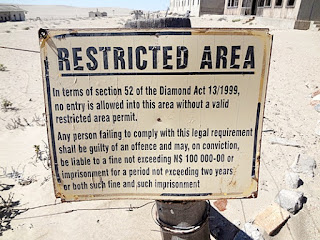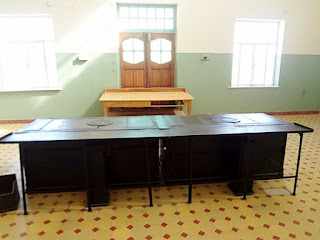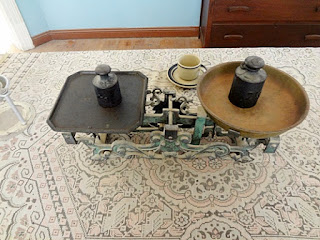Kolmanskop (it means Kolman's Hill) was where a man named Coleman/Kolman had to stop as his wagon was broken down in a sandstorm and was covered in sand here. So this is where they set up the company headquarters for mining diamonds. Actually, they just put contract workers on their bellies and crawled across the sands, picking up diamonds as they went! In the mid-1950's, people realized that there were bigger and more diamonds down near the Orange River and they abandoned this town and set up down there in a new purpose-made town of Oranjemund.
It looks pretty barren on the drive out to Kolmanskop, but a closer look shows lots of interesting rock outcrops. You aren't allowed beyond the side of the road, so we couldn't even wander around to look at them.
The first view of Kolmanskop as we speed along the road. The lady driving us out there was doing about 130 km/hr in a 70 km/hr zone and blew right past the stop signs and railroad crossings. There is no train that runs here yet. She only slowed down to make the turn into the place.
Stuffed animals of the region are on the stage of the old gymnasium in the town. The building housed the stage, gym, restaurant, bar, champagne bar for women, poker room for men and a giant kitchen. They called the building a casino, but the word had a much bigger meaning than just for gambling. The guy with the long straight horns is an oryx. We saw lots of them in Namibia. And we saw the black-backed jackals on a different adventure, as well as the baboons.
The brown hyena, springbok, porcupine and jackal.
Jason viewing the old gym equipment. The Germans here were really into gymnastics and healthy exercise.
The original kitchen stove, used to feed hundreds who came for dinner in the restaurant here.
From the balcony in the gym/auditorium. They even had movies and plays here for the towns people.
The abandoned homes in Kolmanskop are being reclaimed by the sand and dunes and weather.
The wealthiest folks in town once lived here. These homes were the epitome of luxury back in the early 1900's. They are still in amazing shape considering the elements they sit in day in and day out without any maintenance.
The roof has disappeared from this building that I think used to be the post office here. All the buildings start to look the same grey as the sand and rocks of the desert here.

The town had these indoor 'bowling' lanes. They are more like skittles, with the wooden ball that isn't really round. But it did get sent back to you once you rolled it down the lane.
The bowling club sign on the wall from 1927. They called it kegels, not really bowling.
The sand is invading doors and windows here.
Sand blows in the roof and windows and piles up inside. The dune is the only thing keeping this home from collapsing.
The weathered wood would make a great photo study on its own.
Jason in the butchery, hanging on the meat hooks.
I couldn't believe they actually had to post a sign on the door to prevent men from pissing in the butchery! This isn't a new sign, either.

The sand is trying to get in the window and blows through the cracks to sit on the sill.
In the meat shop, there were two of these huge basins they used to make sausages. Our guide told us that the men used to drink heavily here and they'd get hungry and steal all the sausages and eat them at night. The butcher just had to go to the bar to find out who was there late and added the cost to their bills. He always got paid.
Brian in the meat shop. You can see the light around the door where the sand can get in.
Much of the old equipment was left behind. This is a hot water supply.
Another window getting blasted with sand.
An old icebox in the ice factory. True luxury was ice in the desert and these folks in Kolmanskop had all the luxuries of the times. The straw in the container on the wall was used to absorb the humidity in the room where they made the ice. Each home got a block of ice each day, delivered by the little train that ran up and down the street here.
I love the old phone on the corner of the desk. They have kept one home maintained in the original and authentic decor of the day.
Carved wood chairs with leather upholstery and embroidered tablecloths were de rigeur in the day.
The wringer washer in the corner on the sink to do laundry.
Items were sold by weight, so homes had their own scales, too.
The corner stove in the kitchen. This town would be an antique lover's dream.
The water pitcher and basin on the dresser. The walls all had stenciling, too. The paint is not original, but the color is.
Nice furniture. Imagine what it took to drag it across the desert all the way to this town on the coast of Namibia back in the early 1900's.
The little train that delivered water, ice, and women with their shopping bags right to their door.
Some of the old stuff that has been kept in a room acting now as a museum.
A display of a typical hospital room. The hospital here was the last building to be abandoned in 1957.
More old stuff in the museum being admired by Myra and Brian.
The sign at the entrance to Kolmanskop.
Another diamond company building abandoned in the Restricted Area.
Inside some of the homes, the sand just blows in and drifts.
This was the swimming pool for the town, built way up on a hill. It was a salt water pool, complete with a diving board.
Jason climbed the ladder on the outside of the pool and is sitting on the wall. It's a huge pool, but is bare concrete and sand dunes on the bottom now.
Looking across the top of the swimming pool out over the desert towards the ocean.
A view of Kolmanskop from the swimming pool. The desert is such a huge scale; everything looks small in it.
A wooden door has been left to lie on the floor in one of the homes,
Piles of sand accumulate in the rooms of the homes now.This sink won't drain now.
The paint and stencils on the wall are peeling but still discernible up close. This was a kitchen with coffee pot, cups and sugar/creamers stenciled on the far wall.
The sand will never be removed now.
Slats in the roof provide interesting shadows on the sand and door below in this room.
You can imagine what a nice home this once was.
The conservatory off to the side is now open to the elements.
Jason and Myra looking out over the desert.
A closer look at the conservatory of one home. Wind, weeds, weathered wood and sand is all that is left.
One home had imported Italian fixtures and this black and white floor tile is the original.
The bath tub is solid marble with the little water heater in the corner. Again, the tiles are original.
Another view of the homes. The richest man in town used to live in the house on the right.
This building is filled to the rafters with sand.
Jason is walking along the bottom of the dune that is forming between the homes here.
This could be completely covered in a few years.
The sand blows in the back of this house and out this window.
The sand dune in side this house blows down and out and with any wind at all, it can create quite a blast. I think my camera got sand in it here.
The old ceramic bath tubs dot the outside of some of the homes here.
A ghost town scene.
Not much left to hold this structure up against the sand.
Some old hand weights outside of the old casino building. It now houses a coffee shop and souvenir shop, too. On some days, there is a merchant selling diamonds, but the cases were bare when we toured it.
An old stove now used as a planter.


































































No comments:
Post a Comment